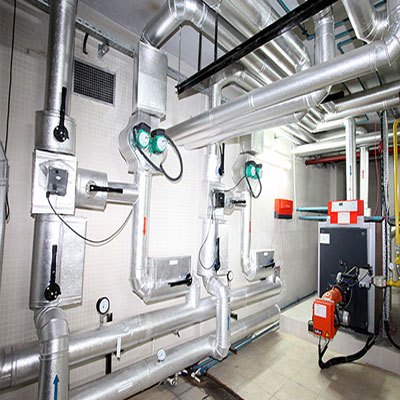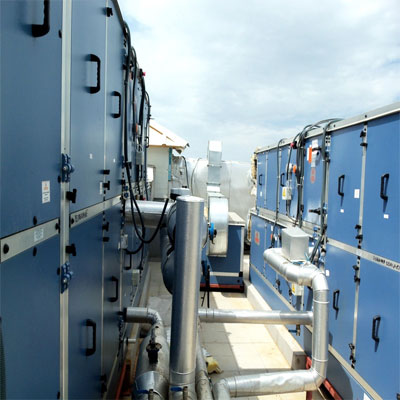

Ventilation installation is a system that provides air flow to closed areas. This system, which ventilates airless environments, continuously transfers fresh air to the indoor environment and provides a more comfortable and spacious area. Ventilation system that eliminates heat and moisture prevents indoor poisoning, fires and explosions. Ventilation systems in different types are of great importance according to their usage areas. Local ventilation system is suitable for single storey office, home and enterprises. Central ventilation systems are also used in multi-storey buildings, hospitals, shopping malls and factories. The ventilation installation system used to prevent the formation of air currents in closed and lint-free environments is subject to the Sağlık Regulation on Health and Safety Conditions in the Use of Work Equipment ”.
It is done to determine whether it meets the criteria specified in the project. Unless otherwise specified in the relevant standards of ventilation installations, periodic inspections of the installations are performed once a year. As long as regular and continuous inspections and inspections of ventilation and air conditioning installations are not performed, they may cause problems and may not work at a time that may be needed. In order to prevent these problems, they are subject to periodic maintenance of the ventilation and air conditioning installations in compliance with the conditions described in the legal regulations. This legal obligation is required by the Regulation on Health and Safety in the Use of Work Equipment, which regulates the minimum requirements for health and safety for the use of construction machinery and equipment in the workplace.
According to the principles of this regulation published by the Ministry of Labor and Social Security in 2013, ventilation and air-conditioning installations are included in the installation article of Annex 3 of the Regulation on Maintenance, Repair and Periodic Controls. In this respect, ventilation and air conditioning installations should be inspected and inspected at least once a year unless any other specific period is specified in the relevant standards. During these works, it is first checked whether the installation meets the criteria shown in the project. Afterwards, it is investigated whether these installations meet the criteria in the standards published by domestic and foreign organizations. In general, determination of the ventilation measurement method in the regular controls of ventilation and air conditioning installations, calculation of required outdoor air amount in terms of operating characteristics and determination of air flow velocity and flow rate with anemometer studies are carried out.
Our company performs the inspections of ventilation and air conditioning installations in accordance with the relevant legal regulations, standards and test methods published by domestic and foreign organizations. A few standards considered in these studies are:
- TS 5895 Rules for the operation and maintenance of central air conditioning and ventilation plants
- TS 12850 Authorized services - Ventilation and air conditioning systems - For air handling units, air conditioners, chillers, fan coils, fans (fans, fans), air purifiers and air curtains etc. - Rules
- TSE CEN / EN 15500-2 Energy Performance of Buildings - Control of heating, ventilation and air conditioning applications - Part 2: accompanying TR prEN 15500-1
- TS EN 12102 Air conditioners - Heat pumps and dehumidifiers air-driven noise-driven compressor driven by electrical energy - Determination of sound power level
Ventilation and Air Conditioning Installation Measurement
What Does Ventilation and Air Conditioning Install?
Central air conditioning and ventilation systems today have a wide range of applications from shopping centers with closed areas to factory facilities, from very high smart buildings to the simplest residences. As long as people continue their lives in closed environments, it will be necessary for the environment to be comfortable and comfortable, the ventilation and air conditioning systems to work correctly regardless of the outside weather conditions, and the system to automatically control the delivery of the conditioned air to the indoor environment. The fact that such a system is managed from a single center reduces the energy consumption to minimum levels.
Sensors (censors) are the most important devices in central air conditioning and ventilation systems. The sensing element is a device that measures the physical changes of the controlled medium and generates signals. These devices monitor and measure a variable. Air conditioning variables are temperature, humidity and pressure. Censors have different types and produce different types of signals. Here are a few types of censorship: temperature censors, humidity censors, dew point sensors, pressure sensing elements, liquid flow sensing elements, level measuring sensors, air flow censors and speed censors.
Temperature censors take advantage of certain properties of substances during their work. For example, they benefit from the expansion of solid, liquid and gaseous materials, the change in electrical resistance, the intensity of electric motor power, or the intensity of light and heat radiation.
Importance of Measurement of Ventilation and Air Conditioning Installation
Regardless of the intended use, heating, ventilation and air conditioning systems (HVAC) need to be well controlled to ensure a certain comfort in all buildings in different climatic conditions. HVAC stands for Heating, Ventilating and Air Conditioning in English and is an abbreviation that stands for heating, ventilation and cooling. One of the best ways to save energy in buildings is to establish effective HVAC control with building management systems. The aim of this study is to provide thermal comfort and indoor air quality as well as to reduce energy costs and to minimize environmental pollutants.
In the nineteenth century, ventilation control in buildings was achieved only by opening windows. However, with the beginning of the twentieth century, the desired ventilation flow rates and temperature control started to be provided with electrical energy. In the 1930s, air conditioning technology started to develop and natural ventilation methods began to be abandoned. Today, it is known what the optimum ventilation flow rates should be and the desired temperature and humidity conditions. Control systems and technologies that will meet these conditions are also developing.
During regular checks of ventilation and air conditioning installations, the following basic measurements are carried out: ventilation installation measurement, air conditioning installation measurement and ventilation fans performance measurement.
In accordance with the Regulation on Health and Safety Conditions in the Use of Work Equipment, regular inspections and inspections of local and general ventilation conditions are required in the establishments. Therefore, the capacity of the ventilation system in operation is measured. At the same time, the hygiene measurement values of the environment and the conditions specified in the standards are evaluated and reported. In accordance with the said regulation, the measurement work must be carried out by mechanical engineers, machine technicians or high technicians. According to the regulation, it should be measured at least once a year whether the ventilation and air conditioning installation will meet the criteria specified in the projects and the relevant standard requirements. By using air flow velocities measured with appropriate test and inspection devices, experimental data are calculated and the available capacities are determined. If these values correspond to the theoretical capacities specified in the project, a certificate of conformity is issued.
Today, there are many test and inspection organizations and they provide ventilation and air conditioning installation measurement services. Within this framework, our organization TÜRCERT Technical Control and Certification Inc. provides ventilation and air conditioning installation measurement services with a competent manager and employee staff and a strong infrastructure.



